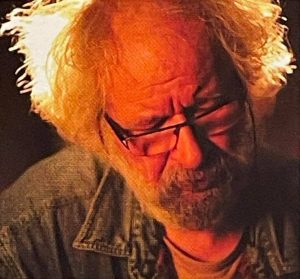
In place of an intro
Following the exhibition held in commemoration of the 100th anniversary of the Bagatela Th eatre, which I had designed and put together in the Palace of the Arts in Krakow, I was approached by the President of Kraków Society of Friends of Fine Arts, Mr Zbigniew Witek, who challenged me to have a go at writing a book on Franciszek Mączyński, an architect, much in the same vein as the one I had already done on Teodor Talowski. In return, he off ered to make the rooms of the Palace available to accommodate a retrospective exhibition of my own works.
I happily accepted the deal. Even though the subsequent COVID pandemic appreciably eroded the resources initially earmarked for the project, certain commitments had already been made. I decided to design a catalogue for the prospective exhibition, thereby offering some insights into the overall nature of my artistic output.
Whilst putting it together with an exhibition in mind, I was still unsure whether it would happen or not, whether I would be able to shoulder its attendant financial burden, or whether I would actually rise to the challenge of making my own exhibition instrumental in promoting the 120th anniversary of the Palace of the Arts in Krakow. The Palace which Franciszek Mączyński had himself designed 120 years back.
Tadeusz Bystrzak
 Ups and downs
Ups and downs
Tadeusz Bystrzak has put together an exhibition where he shares his lifetime output as an artist with the general public. Right at the peak of creativity, he now quietly reflects on his endeavours. The exhibition’s title – „UPS & DOWNS” – unlocks its true meaning. On the one hand, there is satisfaction with having successfully risen to a number of ambitious, yet occasionally demanding challenges, while on the other, disappointment with a self-admitted failure to have actually fl eshed out or made fuller use of certain concepts and ideas.
Tadeusz is highly versatile as an artist. A graduate of the Faculty of Industrial Design, Dept. of Visual Communication, Academy of Fine Arts in Krakow (1980), he is above all a designer. In this particular domain he feels very much at home, only too happy to fall back on the „art and craft” trend, dating back to the 19th c., so that his works are quite rightfully associated with the principle of Gesamtkunstwerk (an all-embracing-art-form).
Being an accomplished designer, he deftly uses his skills in arranging open public spaces, be that through painting large format murals on buildings, or complex interior design in a variety of commercial premises (e.g. shopping centres C.H. Witek’s and Shopping Center M1 in Krakow, restaurants in Warsaw, and even a waterpark in Tarnowskie Góry). When arranging them, he makes ingenious use of any components already in place, designed, purpose-made, and supplemented by himself, as well as all sorts of painting renditions, clearly leaning towards illusionist techniques.
His painting prowess is all the more noteworthy, as he is particularly profi cient in creating realistic representations, an approach rather uncommon nowadays. As he himself admits, „he feels quite comfortable tackling large-format paintings”. He made use of this consummate skill in making a copy of Nero’s Torches (a painting by Henryk Siemiradzki on permanent display in the Gallery of the National Museum in Krakow). Tadeusz also painted two stage curtains, one commissioned by the J. Słowacki Th eatre, i.e. scaled up to full size from an original sketch by Stanisław Wyspiański, and another one, The Abduction of Polonia commissioned by the Bagatela Theatre, this time round in line with his original concept.
He is keen on having tradition and modernity harmoniously combined. He designed advert graphics, grocery packaging (including high-proof spirits), furniture, and constructed complex fi lm sets (e.g. Four Nights with Anna, directed by J. Skolimowski). Tadeusz is particularly fond of tackling small sculpture projects, especially those made of blown glass. „I’ve been dabbing in glass-blowing art all my life, if only occasionally,” as he best puts it himself. Making use of molten glass as a gracefully malleable material, he then proceeds to deftly conjure up all kinds of amazing lamp shades, often quite astounding in shape, extremely popular and esteemed amongst the discerning buyers, particularly abroad.
While focused on his own original works, Tadeusz is invariably guided by respect for the works of other artists. It is not so much about formal inspirations, but rather about his genuine fascination with what actually made them tick. Hence his keen interest in Siemiradzki and Wyspiański, but most of all, in the legacy of Teodor Talowski, a master architect, to whose lifetime achievements he dedicated his defi nitive compendium, a veritable Opus Magnum.
This is how Tadeusz Bystrzak, the designer, made his own inroad into the domain of architecture, and even to the history of art and culture highlighting the turn of the 19th and 20th c. Another appreciable contribution celebrating Krakow’s cultural heritage was the exhibition he held in celebration of the 100th anniversary of the Bagatela Theatre, devised and put together all by himself in the Palace of the Arts, in autumn of 2019. Even though he modestly passed himself off as its curator only.
Tadeusz also took great care to have the entire event commemorated in a special publication, as well as in a documentary fi lm, if only to make sure that it left an imprint. Tadeusz, my Dear Friend, let me tell you how much we appreciate what you have graced us with us so far, while we look forward to you carrying on as usual.
Best of luck with your projects!
Zbigniew Beiersdorf
 Spiritus movens
Spiritus movens
I remember when I first met Tadeusz Bystrzak in Michałowice, at his lecture on Teodor Talowski. I had a chance then to have a peek at the outline of the actual monograph in the making, which now, already published, proudly stands on my own bookshelf. I have to admit that’s one of the best edited publications I have ever laid my hands on (and as an art historian and antiquarian I have seen lots of them). It boasts a truly inspiring content, deftly combining visual appeal with practicality, whilst going far beyond what the title actually calls for. Since that fi rst, brief encounter, I have followed up with great interest and appreciation his artistic endeavours pursued in a diversity of domains.
The way I see him, Tadeusz Bystrzak is invariably associated with activity. He is the driving force behind all the projects, he triggers chains of reactions, he always initiates, creates, and animates, to put it very briefly. He is the one who can always be relied upon to deliver high quality, keep the show on the road, and never hesitate, once he gets going.
A larger copy of Nero’s Torches by Siemiradzki? Having the original interior of Józef Czapski’s room moved from Paris all the way to Krakow? Painting a dozen or so metres long stage curtain based on Wyspiański’s original sketch for the Słowacki Theatre? Devising, assembling, and holding an exhibition in celebration of the 100th anniversary of the Bagatela Theatre? No problem at all…
To my mind, readiness to act stands for one of the artist’s most desirable traits. The most essential one, actually. Then comes another, the crucial one, i.e. attention to detail.
Tadeusz designs large format murals making them blend in unobtrusively with the surrounding architecture, whilst keeping his tongue in cheek most of the time. In the one advertising a chocolate factory, for example, he „unwraps” tinfoil from a chocolate bar in the way meant to highlight the intriguing finials of the building where the advert has ultimately found its place.
He is also fond of playing this cunning tongue-in-cheek game with the viewer in a smaller format, although with the aid of a completely diff erent medium – blown glass. Flowing, softly shaped glass vases and bowls seem to come alive, as if pouring themselves over the table top, only to freeze on its edge (or even beyond), in a manner that forces one to check out whether this glass has really hardened yet, or whether its ostensibly malleable appearance would not cause it to stretch itself all the way down to the floor. All those glass artefacts look like glass sculptures, only too keen to prompt themselves where they wish to be placed to impress most.
If I were to squeeze his artistic endeavours into a single sentence, I’d say this: furious action, great attention to detail, and an impressive momentum maintained throughout.
Several months before, while talking about the album you are now looking through, Tadeusz told me about yet another project he had been working on. Showing me the photograph he said, as if he were acknowledging a mere triviality: „I just got this model made”. I peeked at the photo depicting a griffi n neck of an outsized cello glittering in the sunlight, rounded off with a volute headstock, with the steel ropes tautly stretched along it. T is whole contraption was placed on the trailer of a van, a gigantic instrument several metres long, its „strings” easily capable of supporting a group of acrobats, I guess. Tadeusz simply made himself a „model”, just like that…
Karolina Bańkowska
 Homo artifex
Homo artifex
Tadeusz Bystrzak’s curriculum vitae is uncannily evocative of a mountain stream full of boulder-strewn rapids. His artistic output does cover a pretty wide spectrum indeed, starting off with his fi rst original Berlin exhibition (Objects of Art), stage design and posters for the Student Song Festival in Krakow, through (often realistic) projects, large format murals, complex interior design, right up to an ongoing quest for his very intimate, innovative forms of expression (e.g. blownglass lighting). In his nimble hands, ostensibly ordinary craftsmanship becomes instantly elevated to the rank of Applied Art, clearly dominated by formal austerity, concise in expression, notable for its overall simplicity (both in form and colour), naturally falling in step with the less is more principle…
Gaining insights into the nature of his artistic output is very much like discovering the contents of countless compartments in a bulging chest of his lifetime pursuits. He is so manifestly preoccupied with his artistic visions at all times that seems unable to spare even a minute for grooming his unruly beard anymore… Looks like this ongoing commotion of ideas inside his head may well be finding a secret outlet through a great mane of white, uncombed hair. One just cannot help noticing his obvious likeness to a good-natured, cheerful Santa, who has no trouble attracting keen listeners…Yet underneath this ostensible image of an accomplished conversationalist, one finds an author extraordinaire, brimming with bright ideas, some of them quite stunning, and a tireless demon of creative work!
Successive stages of his artistic pursuits, including a copy of Siemiradzki’s cult painting Nero’s Torches, rather uncannily bring him closer to his great lifetime achievements, i.e. the two stage curtains. If not for all the previously gained experience, also in effective teamwork when commissioned to complete large-format murals, he might well have found those two assignments far more challenging. His past experience in designing film sets and special purpose interiors, apart from being subject to formal constraints, also required efficient working solutions for the in situ set construction.
Wyspiański’s stage curtain (The Słowacki Theatre), followed by The Abduction of Polonia one (The Bagatela Theatre), apart from his book on the life and times of Teodor Talowski, an eminent architect (also known for his unruliness, much like Tadeusz), rate among his greatest lifetime achievements. Suffice to say, it took him nearly 12 years to collect unique archive material for his defi nitive compendium on Talowski – his veritable Opus magnum.
Yet another one of his feats, alas much underrated for some reason, consisted in moving the interior of the original premises, i.e. the great Jozef Czapski’s room from Maison Laffitte, tucked away in a Parisian suburb, to the branch of Krakow’s National Museum. Regretfully, since day one Tadeusz had been fighting a losing battle with the commissioning party with regard to ensuring full reciprocity with the original room…
Tadeusz is a master of illusion, true-to-life imitation, and stage/fi lm set design… Much like Skolimowski, he is driven by sheer passion, stubbornness, and determination in whatever he sets out to do, which, it would appear, leaves no room for any intimacy and family life. Alas, nothing could be further from the truth, for it is precisely his family that offers him all the support he needs, whilst at the same time complementing his eff ervescent and totally unruly artistic personality…
Jan Kurek
 An Encounter
An Encounter
We met on the road somewhere between Krosno and Krakow. Tadeusz often comes down to Krosno for a working spell in the local glass factory. I was on my way back home, as usual carrying along some prize possessions for my art collections. Among them, a Napoleonic cavalry shacko, originally used as a prop in Andrzej Wajda’s 1965 fi lm Ashes. I promptly put it on Tadeusz’s head and took a picture, as if in celebration of our brief encounter on the road…
Having fully appraised myself of the design for a catalogue meant to document his upcoming exhibition, to be held at the Palace of the Arts in Krakow, I can say with full confi dence: „Tadziu, my sincere congratulations to you on being a true Renaissance man.”
Andrzej Kołder
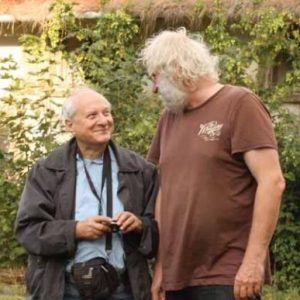 Ups and downs
Ups and downs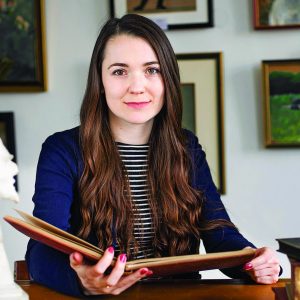 Spiritus movens
Spiritus movens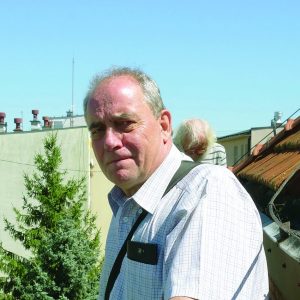 Homo artifex
Homo artifex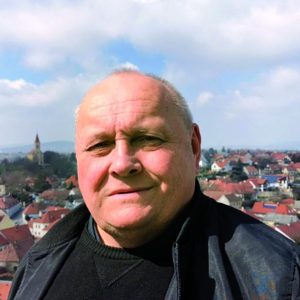 An Encounter
An Encounter